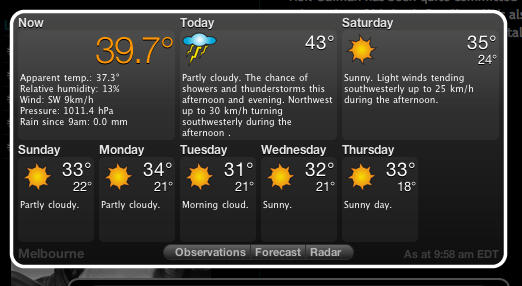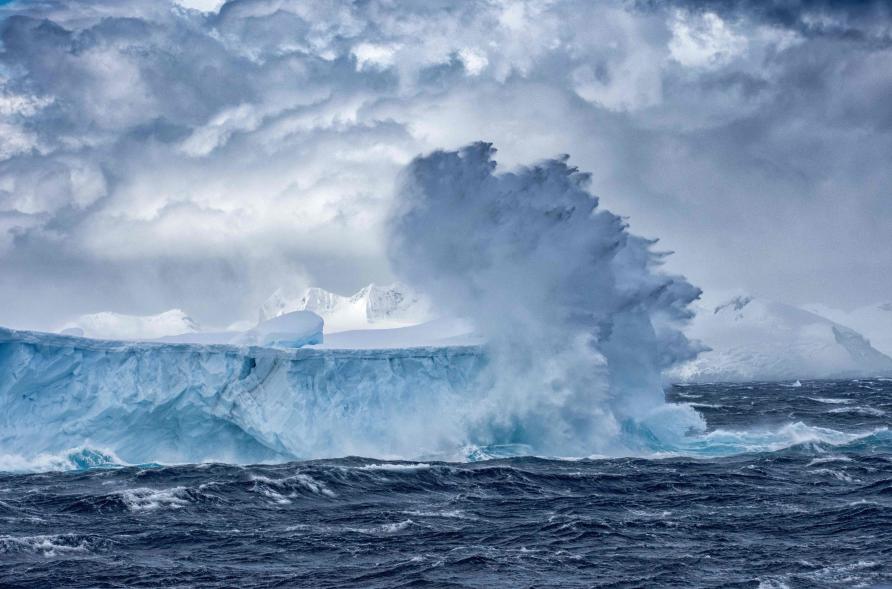Understanding Melbourne’s crazily predictable weather

Freak storms, heat waves and sudden drops in temperature of more than 20 degrees Celsius will be familiar territory for any Melbournian.

Melbourne’s weather can be characterised by sudden extremes.
Dr Linden Ashcroft, a lecturer in Climate Science and Science Communication at the University of Melbourne’s School of Earth Sciences, attributes this variability largely to the city’s geographical position at the intersection of a vast hot continent and the Southern Ocean.
“Heat is a form of energy, and what weather systems want to do is balance the difference in energy between the warm equator and the cold poles. That’s all weather is ever trying to do – make it even,” Dr Ashcroft says.
“North of us is warm land, south of us is cool ocean. If we’ve got a big high-pressure system over the country, the heat inland can really build up. When a cold front then comes through there is often a strong northerly wind ahead of it bringing down that hot air, so the differences between the two systems can be really stark.”
Dr Ashcroft says Melbourne’s sudden temperature drops happen because the cold fronts often have a lot of momentum moving them along.
“It comes down to interaction between different air masses. If you’ve got a big blob of warm air, you need a lot of energy to push it out of the way – that’s when we lose 15 degrees in as many minutes.”
Professor Ian Simmonds from the School of Earth Sciences says in order to understand Melbourne’s weather, it’s important to draw a distinction between the terms ‘predictability’ and ‘variability’.

The sometimes wild swings in Melbourne’s weather can be frustrating, but are a good conversation starter.
“The words are often used interchangeably but they’re actually very different. Just because Melbourne’s weather is very variable doesn’t mean it’s not predictable.”
He also says we need to look at the bigger picture of meteorological events in the rest of the world.
“When we watch the weather forecast on TV, we’re accustomed to just seeing the Australian picture. In meteorology, the way we look at weather and climate now is to look at the whole globe.
“We find that other places in the Southern Hemisphere often experience weather extremes at the same time – there’s a sort of unity with extremes.”
Professor Simmonds explains that a lot of weather phenomena in the Southern Hemisphere are linked to a pattern of very intense low-pressure storm systems that encircle Antarctica. These storm systems are caused by energy generated by the temperature difference between the Antarctic ice mass and the relatively warm water surrounding it.
“These storms are always moving eastward, growing and decaying in this band around Antarctica,” he says.
“There’s an intimate relationship between the Antarctic storms and the cold fronts we see in Melbourne – virtually all of these fronts are connected to a low-pressure system near Antarctica.

Weather in the southern hemisphere is influenced by antarctic storm patterns.
“If you look at northern Australia or the tropics, it’s usually a pretty quiet place in terms of weather systems, with the exception of tropical cyclones – but they’re rare. Things aren’t very variable at all – you can draw a line of latitude at about 30 degrees south and the cold fronts usually don’t penetrate any further north than that.
“These storms down by Antarctica are basically a mechanism for bringing rapid changes of temperature and wind direction. As you go further north, say to Sydney, you don’t really see that same activity.”
Professor Simmonds says the topography of Melbourne and the surrounding area also plays a role in the city’s climate, in particular the Great Dividing Range in northern Victoria.
“Even though the Divide isn’t particularly high, the cold fronts find it harder to get across. As the systems come through, the mountains ‘funnel’ the impact south of the Divide.”
Dr Ashcroft agrees that a range of geographical factors contribute to Melbourne’s weather.
“Two hours north in country Victoria we don’t get the dramatic changes that Melbourne does,” she says.
“The way Melbourne is structured plays a big part in our weather – we get sea breezes from the bay, we’ve got mountains all around us – this all affects the small-scale behaviour of the air, and that adds up to make Melbourne’s beautiful weather.”

The Great Dividing Range affects Victoria’s climate acting by funnelling weather systems.
What about the commonly held belief that the weather is particularly bad on weekends?
“The week is a human construct,” says Professor Simmonds. “There’s no natural seven-day periodicity in the atmosphere. But having said that, we have organised our lives around this seven-day cycle, so the nature of the pollution we emit – when and where we drive our cars for instance – does depend on the day of the week.”
And this pollution can have a range of effects on atmospheric conditions in the city, including rainfall and temperature, he says.
“We do actually find that later in the week and on the weekends it’s somewhat warmer than earlier in the week – just a tiny bit, but it’s statistically significant.”
Professor Simmonds also notes that the life cycle of the low-pressure storms near Antarctica is generally around five to seven days, which can mean that cold fronts often arrive in the city a week apart.
“Once a weather system comes through on a given weekend or a given day of the week, you are possibly going to see a similar system in about five, six or seven days. So if you have bad weather on a weekend, the following Friday may also be a bit nasty.”
While it can be inconvenient, Dr Ashcroft thinks the nature of Melbourne’s weather contributes to the character of the city and its inhabitants.
“Maybe it makes Melbournians a little bit more resilient, or prepared – ready to pivot as required,” she says.
“And what would we talk about if we didn’t have it? You can’t talk about coffee forever, but you can talk about the weather endlessly.”
This article was published by Pursuit.
Sam Burt is a media and content specialist at Melbourne University.














